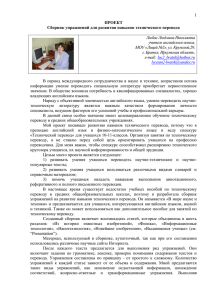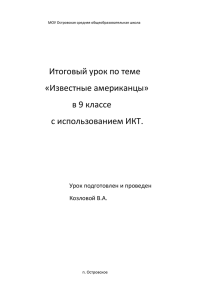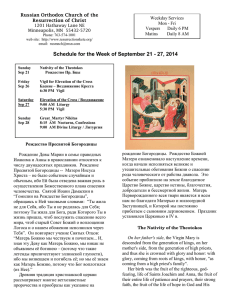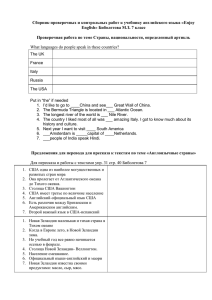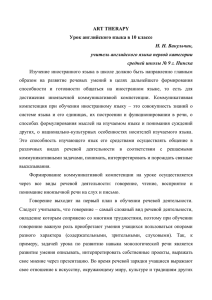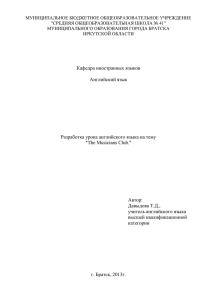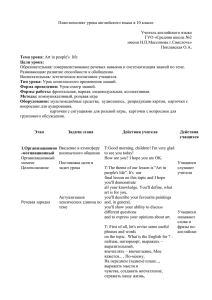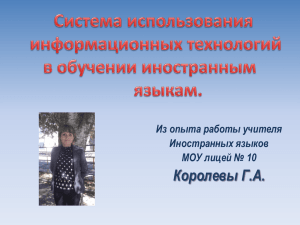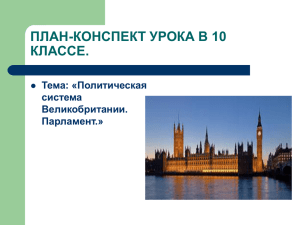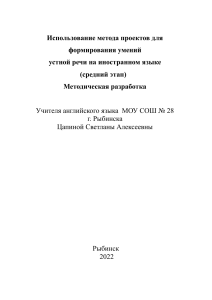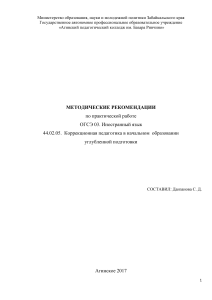Методическая разработка урока английского языка в 11 классе
реклама
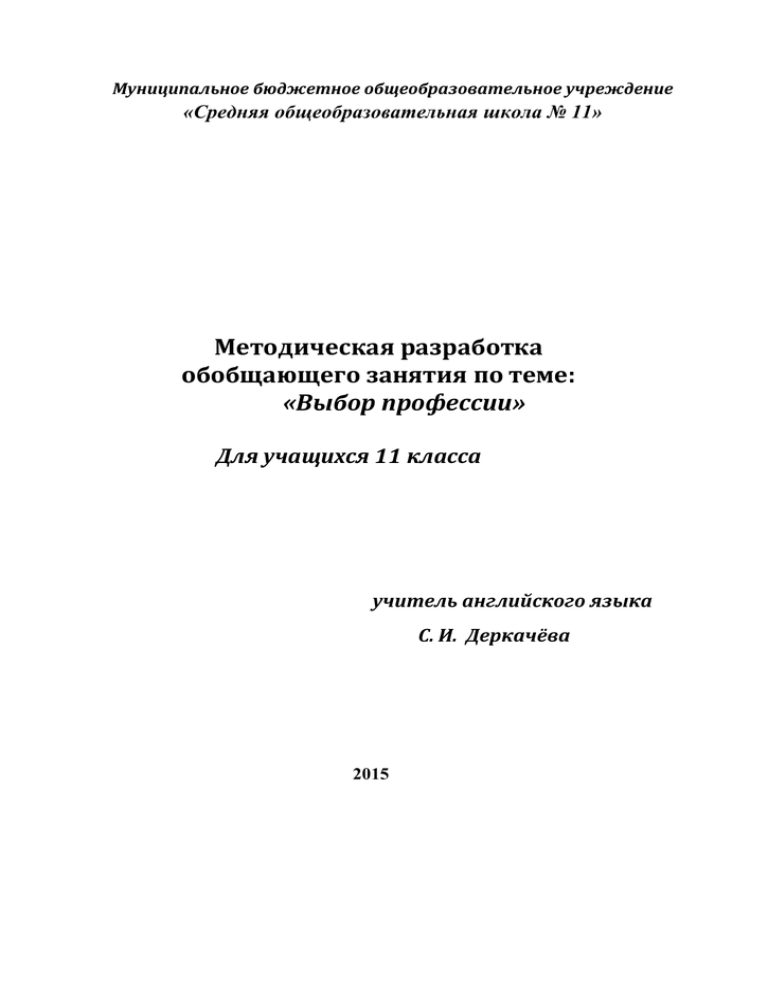
Муниципальное бюджетное общеобразовательное учреждение «Средняя общеобразовательная школа № 11» Методическая разработка обобщающего занятия по теме: «Выбор профессии» Для учащихся 11 класса учитель английского языка С. И. Деркачёва 2015 1. Тема: «The job of your dreams» 2. Тип урока: практико-ориентированный проект с элементами кейсстади. 3. Цель урока: обеспечить самореализацию учащихся как языковой личности в будущей профессиональной деятельности, развивая речевую, языковую, социокультурную, компенсаторную компетенции, поставив в центр обучения познавательную активность. 4. Задачи: образовательные: систематизировать и совершенствовать умения и навыки практического владения английским языком по теме «The job of your dreams»; развивающие: способствовать формированию коммуникативной компетенции, творческого владения средствами и способами иноязычного общения; воспитательные: работать в сотрудничестве, исполняя при этом разные социальные роли, способствовать развитию патриотических качеств у учащихся к малой родине на основе краеведческого материала; 5. Форма обучения: использование технологий социально - развивающегося обучения, методов обучения в сотрудничестве, метода проектов. 6. Оснащение урока: ноутбук, мультимедийный проектор, экран, опорные карты, грамматические таблицы, бланки резюме, тесты, мультимедийное сопровождение с использованием программ Microsoft Word, Microsoft Power Point и Promt, учебные Интернет-ресурсы. План: I. Мобилизирующее начало урока: Ознакомление учащихся с темой занятия, задачами и формами проведения занятия. II. Фонетическая зарядка Активизация употребления в речи учащихся лексики по теме, проводится с использованием программ Microsoft Power Point и Promt, в режиме диктор – учащиеся (английский-английский), учитель-учащиеся (русский-английский) Хорошо образованный-Well-educated Конечный срок подачи- tight deadlines Компьютерная грамотность-Computer literate Творческий-Creative Способность работать в команде-Able to work in a team Способность принимать решения-Able to make decisions Способность решать проблемы-Able to solve problems Способность проводить исследования-Able to do research Умение вести переговоры-Negotiation skills Инициативность-Initiative competent Конкурентно-способность-Competitive Стрессо-устойчивость-Able to cope with stress Мотивированность-motivated Прием в качестве студента – admission as a student Анкетный бланк – application form Дополнительная информация - additional information Финансовая помощь – financial aid Требования к поступающим – entrance requirements Предприниматели - employers работники - employees навыки, необходимые для работы – skills necessary to do the job отбор работников –to hire people личные качества –personal characteristics претендовать на (работу) – depending on a job сдать экзамен (пройти собеседование) – to take a test пройти медицинское обследование – to have a physical examination представить резюме и рекомендации – to submit a resume & references объявление о приёме на работу – job advertisement «требуются на работу» - ''jobs wanted” профессиональный опыт – work experience местонахождение фирмы- the location of the job рабочий день – the working hours II. Речевая зарядка. развитие коммуникативных навыков учащихся (фронтальный опрос) 1.What correspondence must you have with the chosen university? (personal statement, request for application materials, covering letter). 2.What field are you interested in particularly? I am interested in geology, medicine, informational technology, etc. 3.What is your activity at school in this field? During my years at the school I participated in school conferences and received a few rewards for my reports. 4.Do you intend to continue your education after school? As for me, I intend to continue my education after school , may be at the extramural department. 5.Where would you like to study? Why? I would like to study at…State University. It is famous for… 6.What attracts you more: the theory or the practice? The…attracts me more. 7.What is the modern state of your science in our country? I think that …… is developing to the top, there are many reasons for it, and the main is the sharp needs of ………….. for our country & many other countries in the world. IV. Основная часть занятия. а) Обсуждение проблемы дальнейшего образования. проверка навыков диалогической речи. “An interview of your classmates.” Учащиеся готовят диалог на основе вопросов, использованных в речевой зарядке. проверка навыков составления сообщения на основе извлечения основной информации из прочитанного: Заранее учащиеся должны были ознакомиться с двумя текстами, прочитать и перевести с извлечением основной информации. На основе данных текстов написать рефераты, адаптировав содержание текстов для восприятия на слух. При подготовке учащиеся использовали методические рекомендации по выполнению самостоятельной работы (правила написания реферата, речевые образцы по защите проекта). Пример: Reform in the system of secondary education in Russia. 1. Dear members of the Examination Committee and all those present! 2. I’d like to bring your attention to a report on the topic “Reform in the system of secondary education in Russia”. 3. The aim of the report is analysis of peculiarities the reform in the system of secondary education in Russia. 4. School is one of the most important institutions of the society; school reflects the condition of the society and shows tendencies of further development. 5. Therefore, much attention should be paid to education of children to ensure stability and progress in the country. 6. At the same time, the changes in the social and economic life present new demands in the respect of new vision in the upbringing and development of the new generation. 7. In the beginning of the twenty-first century the system of education faces several problems. 8. On the one hand, changes taking place in information technologies and industry highlight the main objectives in education. Modern industry needs qualified, highly professional specialists in many spheres. 9. On the other hand, the overflow of information may become even dangerous for children: the statistics says that only 10 per cent of school-leavers can be considered absolutely healthy today, the other 90 per cent having various health problems. 10. General secondary education is thus extended to eleven years. 11. The curriculum will undergo considerable changes, too. 12. More attention will be paid to new subjects in the curriculum, which are essential economics, information technology, ecology, law, culture, arts, geography, biology and fundamentals of security. 13. Teaching foreign languages at Russian schools will be improved so as to match the international standards. 14. The education in Russia will undergo one more serious alteration in the nearest future. 15. The nationwide system of assessment tests is going to be developed. 16. Admission to the universities will be held on the results of these tests. 17. Thank you for your attention! And now let’s discuss this problem. После прослушивания сообщения, учащимся предлагается высказать свою точку зрения на изменения в сфере образования в России. развитие познавательной активности учащихся, коммуникативных навыков Учащиеся строят высказывания по опорным карточкам. I think that From my point of view To my mind o much attention is paid to bringing up a harmoniously developed individual. o no new subjects are included in the school curriculum. o the term of studies at school will be more than in the past. o only 10 per cent school-leavers in Russia are healthy. o rules of admission to the universities will be altered. Проверка навыков аудирования Tape script NANOTECHNOLOGY: HOW THE SCIENCE OF THE VERY SMALL IS GETTING VERY BIG Written by Mario Ritter 07 February 2006 Учащимся предлагается прослушать аудиозапись текста и выполнить тестовые задания. Опрос проводится после прослушивания каждой части. В качестве опорной лексики учащиеся используют карточки. Тесты для проверки понимания прослушанного текста. Part 1 1. Nanotechnologists work with materials (a) about the size of one millimeter (b) about the size of atoms and molecules (c) as thin as paper 2. The invention of the scanning tunneling microscope enabled scientists to observe... (a) the structure of water (b) distant objects in space (c) molecules and even atoms in greater detail than ever before 3. The speech "There's Plenty of Room at the Bottom" by a Nobel Prize winner Richard Feynman is discusses the theory... (a) that scientists can make devices about the size of atoms (b) that carbon dioxide can be turned into carbon sixty (c) that scientists cannot go further than the size of atoms in making devices Part 2 4. When did scientists first begin to think about using nanotechnologies to make extremely small devices? (a) after the period of industrial revolution (b) after the development of carbon nana-tubes (c) after IBM supported research 5. What was not mentioned in the report as a use of the nanotube? (a) film (b) flat material (c) glass 6. Where, according to the report, can nanotechnologies be used? (a) in production of sporting goods and machines that reduce air pollution (b) in the machine building industry (c) in the computer design industry б) обсуждение проблемы трудоустройства. The second point of our project is the problem of searching for a job. проверка навыков чтения и перевода Чтение и перевод текста 21, стр.50. Защита презентаций: проверка навыков работы с ММП; тренировка коммуникативных навыков. 1. Презентация «ГОК - градообразующее предприятие Губкина». (комментируют 4 ученика) После защиты презентаций проводится краткое обсуждение. проверка навыков заполнения деловых бумаг. учащимся предлагается заполнить образец резюме, раздаются бланки, в которые они вносят свои данные. Предварительно учащиеся знакомятся с основными требованиями написания резюме. HOW TO WRITE A CV OR RESUME? КАК ПИСАТЬ РЕЗЮМЕ? A good resume should: 1. Attract attention. 2. Create a positive impression. 3. Present your skills and qualities clearly and concisely. Resume writing tips Хорошее резюме должно: 1. Привлечь внимание. 2. Создать положительное впечатление 3. Представить ваши навыки и качества ясно и кратко Советы как писать резюме 1. Use concise language. 1. Не будьте многословными. 2. Minimize or omit everything that is irrelevant. 3. Place the most important information at the beginning of your resume. 4. There must be no grammatical errors in your resume 2. Сведите минимум или опустите все, что не относится к делу. 3. Поместите наиболее важную информацию в начале вашего резюме 4. В вашем резюме не должно быть грамматических ошибок. 5. Let an experienced person read your resume. 5. Давайте ваше резюме прочитать опытному человеку. 6. Print your resume on good paper. 6. Напечатайте ваше резюме на хорошей бумаге. Образец резюме An example of Curriculum Vitae 1. Personal Details Name Address Telephone E-mail Date of birth Family 2. Education 3. Professional Experience 4. Skills 5. Activities 6. References V. домашнее задание В качестве домашнего задания предлагается: выучить предложения наизусть, содержащие советы по трудоустройству; сделать рекламный проект службы занятости. Учащиеся прослушивают дважды предложения-рекомендации в записи, с использованием программы PROMT. VI. Рефлексия. VII. Подведение итогов. Приложения. 2.Текст для аудирования. Tape script NANOTECHNOLOGY: HOW THE SCIENCE OF THE VERY SMALL IS GETTING VERY BIG Written by Mario Ritter 07 February 2006 Part 1 Listen to Explorations (MUSIC) VOICE ONE: I'm Steve Ember. VOICE TWO: And I'm Faith Lepidus with Explorations in VOA Special English. Today we tell about one of the most important research fields in technology. It is called nanotechnology. It is the science of making things unimaginably small. But there is nothing small about the problems that scientists hope nanotechnology will solve. (MUSIC) VOICE ONE: Nanotechnology gets its name from a measure of distance. A nanometer, or nana, is one-thousand-millionth of a meter. This is about the size of atoms and molecules. Nanotechnologists work with materials this small. Many experts credit the idea to physicist Richard Feynman. In nineteen fifty-nine, this Nobel Prize winner gave a speech. He called it "There's Plenty of Room at the Bottom." Mister Feynman discussed the theory that scientists could make devices smaller and smaller — all the way down to the atomic level. Although he did not use the word nanotechnology, the speech got many scientists thinking about the world of the very small. But for years this idea remained only a theory. VOICE TWO: At the time, no way existed to record structures the size of molecules. Not even electron microscopes could do the job. But as the nineteen eighties began, two researchers found a way. Gird Binnig and Heinrich Rohrer worked at a laboratory in Zurich Switzerland. They worked for IBM, the American company International Business Machines. They invented what they called a scanning tunneling microscope. This permitted scientist to observe molecules and even atoms in greater detail than ever before. VOICE ONE: Once they could see nano-sized structures, the next step for scientists was to find a way to create their own. By the middle of the nineteen eighties, scientists had increased their research on carbon. They were interested in the ability to use this common element to make nano-sized structures. Carbon had already been engineered in chemical reactions to make long poly-carbon chains. Today, the result of carbon chemical engineering is everywhere — in the form of plastic. Scientists in the nineteen eighties wanted to create nano-structures from carbon atoms. In nineteen eighty-five, Robert Curl, Harold Kroto and Richard Smalley succeeded. They aimed a laser at carbon. This powerful light caused some of the carbon to become a gas. The scientists cooled the gas to an extremely low temperature. Then they looked at the carbon material that remained. They found, among several kinds of carbon, a molecule of sixty atoms — carbon sixty. VOICE TWO: Carbon sixty is a group of tightly connected carbon atoms that forms a ball. It is a very strong structure. This is because all the atoms share any loose electrons that might take part in chemical reactions with other atoms. This kind of molecular carbon can also appear with different numbers of carbon atoms. There is also carbon seventy, for example. For their work, Robert Curl, Harold Kroto and Richard Smalley received the Nobel Prize in Chemistry in nineteen ninety-six (MUSIC) Part 2 VOICE ONE: The next nano-structure development came in nineteen ninetythree. Japanese scientist Sumio Iijima of the company NEC developed carbon nanotubes. These nano-sized objects are really six-sided atomic structures connected to form a tube. They are extremely strong. Scientists believe that someday nanotubes could replace the carbon graphite now used to make airplane parts. Soon after this discovery, researchers started to think about using nanotubes to build extremely small devices. In two thousand three, IBM announced that it had made the world's smallest light. Researchers used a carbon nanotube attached to a silicon base. They sent opposing electrical charges down the tube. The reaction between the charged particles produced an extremely small amount of light. IBM says the wavelength of light produced could be used in communications. VOICE TWO: Nanotubes appear to have many different uses. Scientists at the University of Texas at Dallas have developed a way to make a flat material, or film, out of nanotubes. The researchers create the super thin film by chemically growing nanotubes on a piece of glass. They use another piece of sticky material to remove the film of nanotubes from the glass. When the film is finished, it is only fifty nanometers thick. That is about one one-thousandth the width of human hair. The material is extremely strong and it carries electricity as well. Researchers think the nanotube material could be used to make car windows that can receive radio signals. They also believe it could be used to make solar electricity cells, lights or thin, moveable displays that show pictures like a television. VOICE ONE: Nano-materials are already being used in some products. For example, materials using mixtures of nano-materials are being used to make sporting goods like tennis balls and tennis rackets better. Soon, nano-materials could be used to improve devices that reduce pollution released by cars. Similar technology could be used to warn of the presence of poisonous molecules in the air. (MUSIC) Примечание: Аудио запись программы можно бесплатно скачать из сети Интернет с официального сайта «Голос Америки» http://www.voanews.com/special-english/archive/2006-02/2006-02-07-voa3.cfm 2. Предложения для домашнего задания: DOs and DON’Ts for Job Seekers (Что НАДО и что НЕ НАДО делать в поисках работы) DO apply for a job in person. Обращайтесь за работой лично. DO let as many people as possible know you are «job hunting. » Пусть как можно большее число людей знает, что Вы ищите работу. DO stress your qualification for the job opening. Подчеркивайте, что Вы имеете квалификацию, необходимую для данной работы. DO mention any experience you have. Опишите приобретенный Вами опыт. DO try to be optimistic in your attitude. Старайтесь быть оптимистом. DO maintain your poise and self-control. Проявляйте выдержку и контролируйте себя. DO try to overcome nervousness. Не нервничайте. DO answer questions honestly. Отвечайте на вопросы честно и прямо. DO have a good resume. Имейте при себе хорошее резюме. DO recognize your limitations. Признавайте свои недостатки. DO make plenty of applications. Делайте много запросов. DO indicate your flexibility and readiness to learn. Подчеркивайте Вашу гибкость и готовность учиться. DO be well-groomed and appropriately dresses. Старайтесь произвести впечатление ухоженного человека и одевайтесь соответственно случаю. DON`T keep stressing your need for a job. НЕ подчеркивайте, что Вы нуждаетесь в работе. DON`T apologize for your age. НЕ извиняйтесь за свой возраст. DON`T hesitate to fill out applications, give references, take physical examinations or tests on request. НЕ колеблясь, заполняйте анкеты, предоставляйте отзывы, выполняйте физические и другие тесты по просьбе работодателя. DON`T isolate yourself from contacts that might help you find a job. НЕ избегайте контактов, которые могли бы помочь Вам найти работу. 3. Set-Phrases for Project Defense Речевые клише для защиты проекта 1. Уважаемый председатель экзаменационной комиссии! Уважаемые члены экзаменационной комиссии! Уважаемые присутствующие! 1. Dear Examination Committee Chairman, members of the Examination Committee and all those present! 2. Вашему вниманию предлагается учебно-исследовательский проект на тему… 2. I’d like to bring your attention to a research project on the topic… 3. Целью проекта является - знакомство с… (показ…) - выявление особенностей… - исследование проблемы… - сравнение культур… 3. The aim (goal) of the project is - introduction to (demonstration)… - analysis of peculiarities… - investigation of the problem… - comparison of the cultures… 4. Практический результат проекта представлен в форме: - буклета (проспекта); - видеофильма и его сценария; - альбома и др. 4. The end product of the project is presented in the form of: - a booklet; - a video and its script; - an album, etc; 5. Основное содержание проекта дано в форме портфолио: - краткая информация об истории… (тексты №№…); - реклама; - речь экскурсовода; -описание наиболее значимых явлений (событий, достопримечательностей) и др. 5. The main contents are introduced in a portfolio containing: - a brief historical overview… (Texts No…) - advertisements; - the Guide’s speech; - a description of the most important events, places of interest, etc. 6. Мне особенно понравилось в проекте… 7. Я встретился с трудностями… 6. What I like the most about the project is… 7. I encountered the following difficulties… 8. Главным практическим результатом 8. The main result is… является… 9. Я полагаю, что результаты данной 9. I believe that the outcomes of this проектной работы можно использовать… Research project can be applied to… 10. Благодарю за внимание! 11. А теперь вопросы по проектной работе. 10. Thank you for your attention! I really appreciate your attention! 11. And now your questions on the project, please. 4. Текстовое сопровождение презентаций: Presentation by topic: “LEBEDINSKY MINING & DRESSING PLANT” 1. Nature has favored us with the unique treasures in the womb of Kursk Magnetic Anomaly and our duty is to use it reasonably for the welfare. 2. In 1966 the Government has taken a decision to construct Mining and Dressing plant on the base of Kursk Magnetic Anomaly (KMA) to extract and proceed iron ore. 3. As to reserves, concentration, quality and technological characteristics of overburden rocks and iron ore the raw materials of enterprise is the unique and can provide long time enterprise operation, its extension and even constructions of new mining & dressing plant to proceed iron ore & produce construction materials as well. 4. The first and the most important section of technological line is a mine. 5. Powerful modern equipment is at the disposal of miners. 6. Lebedinsky GOK produces and dispatches to customers the following iron ore products: Iron ore concentrate, Fe-content 67,5 – 68 %; Overdressed concentrate for secondary metallurgy, Fe – 70 %, silica – not more than 3 %, Iron ore pellets, Fe – up to 66 %. 7. Prospects. 8. We create our own base of construction industry; extend manufacture of the consumer goods and different services. 9. What is the reason for our enterprise’s constant and dynamical development? Continuous and objective increase of the demand for manufactured materials, operative and high quality order fulfillment, considerable investments in high technologies. 10.Care of people. The private cottages and modern dwelling houses are constructed in Gubkin and Stary Oskol. 11.Much attention is paid to the solving of the accommodation problem, improving health care, sport facilities and so on. 12.It is our duty to save environment using treasures of bowels. 13.You are welcome to Lebedinsky Mining & Dressing plant. 14. Lebedinsky GOK is a reliable partner! Список используемой литературы: 1. М.З. Биболетова, Е.Е. Бабуис, Н.Д. Снежко «Английскийский с удовольствием» - учебник для 11 класса общеобразовательных учреждений – 3-е издание, издательство «Тиул» 2013 год. 2. Журналы «Иностранные языки в школе» 3. http://www.voanews.com/special-english/archive/2006-02/2006-02-07voa3.cfm
